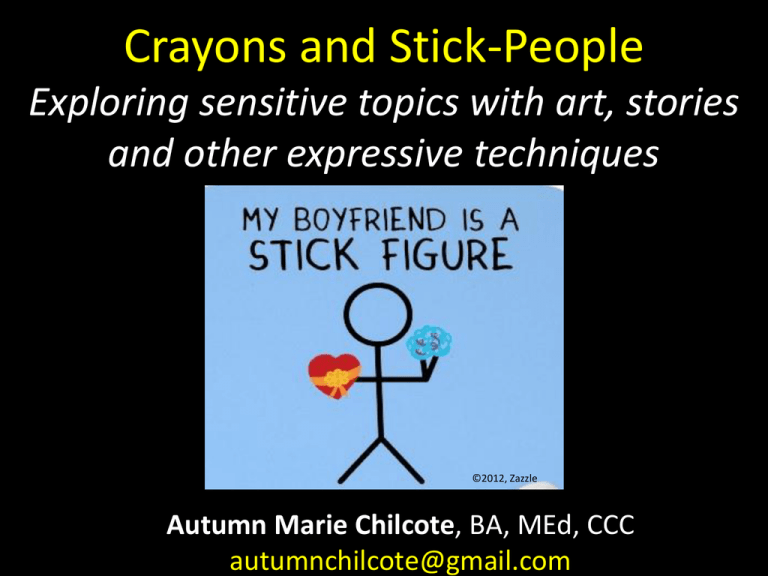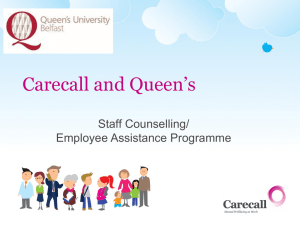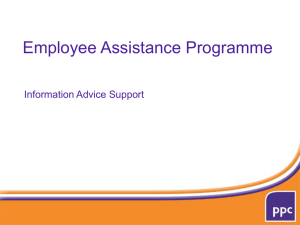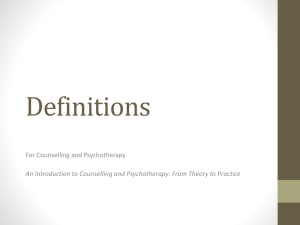
Crayons and Stick-People
Exploring sensitive topics with art, stories
and other expressive techniques
©2012, Zazzle
Autumn Marie Chilcote, BA, MEd, CCC
autumnchilcote@gmail.com
Sensitive Topics
List THREE topics that
are sensitive to YOU.
©n.d., visualphotos.com
List TWO that may be
sensitive to CLIENTS.
©2001, uci.edu
©2013, Chilcote, A.M.
Art-making
Sex and other bodily functions
God, etc
Social Justice
Money
Body Image
Intelligence
©2013, Chilcote, A.M.
©n.d., sketchfu.com
Sensitive Topics
Crayons and Stick People
Topics
Techniques
Materials
Samples
Lots of
practice
©2013, Chilcote, A.M.
©Banksy, 2011
Maps
How do you access
sexual health
education?
©2001, uci.edu
“I already know all this stuff.”
“I don’t need it.”
“I don’t know.”
©2013, Chilcote, A.M.
Maps
•Complexity
•Co-existing ideas
•Externalizing
•Integrating
©2013, Chilcote, A.M.
•Sexual health
•Abuse
•Justice
•Safety
Augusta-Scott, 2007; Ludwig, 1997; Pifalo, 2009; Poehnell & Amundson, 2011
Maps
“I know it’s bad but I
don’t know how to
stop…”
What would you prefer?
What do you believe is
true for others?
©2013, Chilcote, A.M.
Maps
©2013, Chilcote, A.M.
Maps
•Significance
•Exceptions
•Imagined Future
•Spirituality
•Substance Misuse
•Ethics
•Combat Trauma
©2013, Chilcote, A.M.
Topic
Duvall & Beres, 2011; Hagemans et al, 2013
•Embedded
•Transactional
•Systems
•Solutions
•Hope
•Family
•Illness
•Justice
©2013, Chilcote, A.M.
Maps
Most Distant
Not So Close
Closest Ideas
Me
Duvall & Beres, 2011; Milewski-Hertlein, 2001; Rempel, Neufeld & Kushner, 2007
Workshop!
Choose a map...
How did you get
here?
Where are you
going?
©2013, Chilcote, A.M.
Make it Yours
MATERIALS
White paper
Pen or pencil
Crayon if desired
ALTERNATES
Maze
Treasure Map
Road Map
©2013, Chilcote, A.M.
Circles
•Order/Disorder
•Beliefs
•Emotions
•FASE/D
•Couples
•Nursing Philosophy
•Trauma
©2013, Chilcote, A.M.
Frame, 2006; Gerteisen, 2008; Henderson et al, 2007; Hwang, 2011; Jung, 1964; Marshall, 2003
•Physiology
•Focus
•Relief
•Motivation
©2013, Chilcote, A.M.
Circles
Anderson, 2002; Schrade, Tronsky & Kaiser, 2011; van der Vennet & Serice, 2012
Workshop!
Focus on your breath.
Start from the centre,
spiral outward.
Exhale deeply, inhale and
spiral outward.
Exhale deeply, inhale,
spiral outward and hold to
the outer edges of the
page…
©2013, Chilcote, A.M.
Make it Yours
MATERIALS
Paper
Pen or pencil
Crayon if desired
Forms?
©2013, Chilcote, A.M.
ALTERNATES
Centre Point
Pie Pieces
Outside In
Outside Only
Printable Forms
Stories & Poems
•“Symbolic mediator”
•Identity
•Emotion & Self-soothing
•Sobriety & Substance Use
•Self-harm
•Chronic Illness & Death
•Stepfamilies
©2013, Chilcote, A.M.
Adamo et al, 2008; Chapadjiev, 2008; Church, 1999; Hinz, 2006
Stories & Poems
FAIRY TALES
•Good Character
•Bad Character
•Magic
•Happy Ending
©2013, Chilcote, A.M.
SHORT SHORTS
•One Sentence
•Three Sentence
•Prompts
•Characterizations
Workshop!
Write from the
perspective of your “pet
parrot.” How would s/he
describe you?
One strength
One weakness
We get along when…
When we fight, we make
up by…
©2013, Chilcote, A.M.
MATERIALS
Paper
Pen or pencil
Prompts (optional)
Letter Writing
•Relational Skills
•Emotional Attendance
•Self- Analysis
•Biology
ALTERNATES
•Three Sentences
•Past/ Future
•Grandchild
©2013, Chilcote, A.M.
Practical Scientists
“A practice-oriented introduction to
building an evidence base for counselling
and psychotherapy”
“Practice-based evidence in school-based
counselling”
“Evaluating the processes and
outcomes of vocational counselling”
©2013, Chilcote, A.M.
Hanley, Sefi & Lennie, 2011; Henton, 2012; Hiebert et al, 2011; Young, 2009
Make it Yours
MATERIALS
File review
Progress/Outcomes
SurveyGizmo?
©2013, Chilcote, A.M.
Stick People, Body Parts
•Positioning
•Development
•Communication
•Interpretation
©2013, Chilcote, A.M.
•Sexuality
•History
•Violence
•Cancer
•Supervision
Brown, 1986; Buchalter, 2004; Chilcote, 2011; Wright, 2007
Workshop!
What mood is your
THUMB currently in?
Trace your thumb.
Fill it in however you
like.
Fill in the surroundings
if you like.
©2013, Chilcote, A.M.
MATERIALS
Paper
Crayons
Challenges
Time Management
Reflection
Humour
Motivation
Bring your Best Self
©2013, Chilcote, A.M.
Autumn M Chilcote, BA, MEd, CCC
autumnchilcote@gmail.com
References
Adamo, S. et al (2008). Tom Thumb in hospital: The fairy tale workshop in a paediatric oncology and haematology ward.
Psychodynamic Practice, 14(3), 263-280.
Anderson, T. (2002). Mandala: Constructing peace through art. Art Education, 55, 33-39.
Aronoff, D. & McCormick, N. (1990). Sex, sex role identification and college students’ projective drawings. Journal of
Clinical Psychology, 46, 460-466.
Augusta-Scott, T. (2003). Dichotomies in the power and control story: Exploring multiple stories about men who choose
abuse in intimate relationships. In Responding to violence: A collection of papers relating to child sexual
abuse and violence in intimate relationships, pp 204-224. Adelaide: Dulwich Centre Publications
Augusta-Scott, T. (2007). Letters from prison: Re-authoring identity with men who have perpetrated sexual violence. In
Narrative Therapy: Making Meaning, Making Lives. Toronto: Sage.
Berends, L. (2011). Embracing the visual: Using timelines with in-depth interviews on substance use and treatment. The
Qualitative Report, 16(1), 1-9.
Brown, V.H. (1986). The integration of self-identity and self-esteem through curriculu developent. Chicago: Native
American Educational Services.
Buchalter, S. (2004). A Practical Art Therapy. London: Kinglsey.
Chapadijev, S. Ed.) (2008). Live Through This: On creativity and self-destruction.
Church, E. (1999). The poisoned apple: Stepmothers’ experience of envy and jealousy. Journal of Feminist Family
Therapy, 11(3), 1-18.
Cohen, B., Barnes, M. & Rankin, A. (1995). Managing Traumatic Stress Through Art. NY: Sidran.
Curry, J. (2009). Examining client spiritual history and the construction of meaning: The use of spiritual timelines in
counseling. Journal of Creativity in Mental Health, 4(2), 113-123.
Duffey, T. (date?) Creative Interventions in Grief and Loss Therapy. Publisher?
Duvall, J. & Beres, L. (2011). Innovations in Narrative Therapy. NY: Norton.
Frame, P.G. (2006). Assessing a couple’s relationship and compatibility using the MARI Card Test and Mandala Drawings.
Art Therapy, 23(1), 23-29.
Gerteisen, J. (2008). Monsters, monkeys & mandalas: Art therapy with children experiencing the effects of trauma and
fetal alcohol spectrum disorder. Art Therapy, 25, 90-93.
©2013, Chilcote, A.M.
References
Hagemans, M. van der Maij, H., de Jong, T. (2013). The effects of a concept map-based support tool on simulation-based
inquiry learning. Journal of Educational Psychology, 105, 1-24.
Hanley, T., Sefi, A. & Lennie, C. (2011). Practice-based evidence in school-based counselling. Counselling & Psychotherapy
Research, 11, 300-309.
Henderson, P., Rosen, D. & Mascaro, N. (2007). Empirical study on the healing nature of mandalas. Psychology of
Aesthetics, Creativity and the Arts, 1(3), 148-154.
Henton, I. (2012). Practice-based research and counselling psychology: A critical review and proposal. Counselling
Psychology Review, 27. 11-28.
Hiebert, B., Domene, J. & Buchanan, M. (2011). The power of multiple methods and evidence sources: Raising the profile
of
Canadian counselling psychology research. Canadian Psychology, 52, 265-275.
Hinz, L. (2006). Drawing from Within: Using art to treat eating disorders. London: Kingsley.
Ho, R. et al (2010). Changes in breast cancer patients after psychosocial interventions as indicated in drawings. PsychoOncology, 19(4), 353-360.
Hwang, K. (2011). The mandala model of self. Psychological Studies, 56(4), 329-334.
Jung, C. (1964). Man and his symbols. NY: Dell Pub Co.
Ludwig, S. (1997). Abused women’s experience wit the justice system: Concept mapping. Dissertation Abstracts I
nternational: Humanities and social Sciences, 58(5-A), 1602.
Lowenstein, L. (n.d.) Original Therapeutic Resources for Mental Health Practitioners and Families.
www.lianalowenstein.com
Ludwig, S. (1997). Abused women’s experience wit the justice system: Concept mapping. Dissertation Abstracts
International: Humanities and social Sciences, 58(5-A), 1602.
Marshall, M. (2003). Creative learning: The mandala as a teaching exxercise. Journal of Nursing Education, 42, 517-520.
McLeod, J. & Elliott, R. (2011). Systematic case study research: A practice-oriented introduction to building an evidence
base for counselling and psychotherapy. Counselling & Psychotherapy Research, 11(1), 1-10.
Milewski-Hertlein, K. (2001). The use of a socially constructed genogram in clinical practice. American Journal of Family
Therapy, 29, 23-38.
©2013, Chilcote, A.M.
References
Pifalo, T. (2009). Mapping the maze. Journal of the American Art Therapy Association, 26(1), 12-18.
Poehnell, G. & Amundson, N. (2008). Hope-Filled Engagement. Vancouver: Ergon.
Presbury, J. Echterling, L., & Mckee, J. (2008). Beyond brief counseling and therapy: An integrative approach. NJ: Pearson.
Rabaia, Y., Nguvetv, V., Giacaman, R. (2011). The Gaza Diamond: Drawings and wishes of Palestinian teenagers.
International Journal of Mental Health, 9, 44-52.
Rempel, G., Neufeld, A. & Kushner, K. (2007). Interactive use of genograms and ecomaps in family caregiving research.
Journal of Family Nursing, 13, 403-421.
Schrade, C., Tronsky, L. & Kaiser, D. (2011). Physiological effets of mandala making in adults with intellectual disabilities.
Arts in Psychotherapy, 39(2), 109-113.
Schwednimann, B. (2011). Mapping biological ideas: Concept maps as knowledge integration tools for evolution
education. University of California: Berkeley.
Simmons, C. & Rycraft, J.R. (2010). Ethical challenges of military social workers serving in a combat zone. Social Work, 55,
9-18.
Stone, D. & Amundson, N. (1989). Counsellor supervision: An exploratory study of the metaphoric case drawing method
of case presentation in a clinical setting. Canadian Journal of Counselling, 23, 360-371.
Sunday Scribblings. (2013). Sunday Scribblings. www.sundayscribblings.blogspot.ca
Valadez A. & Evans, M. (2005). A Novel Approach: Using literary writing and creative interventions for working toward
forgiveness after relationship dissolution and divorce. Journal of Creativity in Mental Health, 1, 103-121.
Van der Vennet, R. & Serice, S. (2012). Can coloring mandalas reduce anxiety? A replication study. Art Therapy, 29(2), 8792.
Wright, S. (2007). Meaning-making through drawing and telling. Australian Journal of Early Childhood, 32, 37-48.
Young, R. (2009). Evaluating the processes and outcomes of vocational counselling: An action theory perspetive.
Orientation Scolaire et Professionnelle, 38(3), 281-306.
©2013, Chilcote, A.M.







